Before you do anything else, listen to this first.
I was inspired to do this on Dave Steed’s recent ”Rock End of the 80s,” when ”Ana Ng” recently came up, because of the ensuing comments that They Might Be Giants hadn’t recorded anything worth listening to since about 1992. ”Au Contraire, mon frÁ¨re!” I stated, and decided a Popdose TMBG guide was in order. Flagbearers and virtual inventors of ”geek rock” (though one could make a case for Frank Zappa with that I suppose), they were not the first band to mix rock and roll with lyrics about largely non-romance-related topics, but they were one of the first to do that outside the context of prog rock or metal and not have it be universally dark and depressing.
Taking philosophical cues from avant-garde artists such as Zappa and Devo, musical cues from a Beatles / Byrds / Beach Boys / Raspberries harmonic power-pop base but with their own willingness to layer anything and everything on top of it, John Linnell and John Flansburgh, the self-proclaimed ”Twin Quasars of Rock and Roll,” are like no other band on earth. Originally from Lincoln, Massachusetts (hence the title of their second album), the Johns met as teenagers and wrote songs together, but reunited for good in Brooklyn in 1981.
For several years they were a popular house band at a Lower East Side club, with a now-legendary absurd show that I would’ve loved to have seen, and they finally got their break in 1985 when their demo cassette got reviewed in People magazine, of all places. They also invented the ”Dial-a-song” service, quite possibly the earliest form of on-demand music (by phone until 2000, then by internet, and currently in podcast form), originally as a stopgap measure when Linnell’s broken wrist forced them to take a break from performing.
If you want to start somewhere with them, my personal recommendation is to start with their third album Flood but as long as you like it (and I’ve yet to meet anyone who doesn’t), go immediately to Then, the reissue of their first two records along with all the great EP-only tracks from that era and many others. I’ll keep the albums separate for reviewing purposes though, and then go down the line of full length studio releases, all the way to the present, with their newly-released Join Us album.
 They Might Be Giants (1986): Unlike many innovative bands whose first recordings only resemble what they would eventually achieve in embryonic form, TMBG had a vision right from the start, and came out swinging immediately with an album that embodies everything theyre about.
They Might Be Giants (1986): Unlike many innovative bands whose first recordings only resemble what they would eventually achieve in embryonic form, TMBG had a vision right from the start, and came out swinging immediately with an album that embodies everything theyre about.
Although there is a certain amount of dated-sounding noodling, that’s a lot of its charm; the drum machines, accordion, power-pop / folk stylings, seamless genre-shifting, and lyrical wackiness sounded like nothing else at the time, and still don’t. What kind of rock and roll band sings songs with titles like ”Chess Piece Face ,” ”Nothing’s Gonna Change My Clothes” and ”Rhythm Section Want Ad?” This was their New York underground sound brought to fruition, and hardly watered down at all. Supremely intelligent without being condescending, and often hilarious, there’s hardly a weak point.
”Don’t Let’s Start” was the college radio hit that put them on the map, but there’s so much more here. ”32 Footsteps” is a song about a man obsessed with the number 32, ”Alienation’s For the Rich” is a country send-up that lovingly mocks the style (”and the TV’s in Esperanto / don’t you know that that’s a bitch”), ”Youth Culture Killed My Dog” and ”Absolutely Bill’s Mood” just have to be heard to be believed. My favorite is ”Put Your Hand Inside the Puppet Head,” somehow both the most 80s of the bunch and also the most timeless.
Also highly essential are the bonus tracks from their early EPs, such as ”The Famous Polka,” (which they still play live all the time as far as I know) ”Mr. Klaw,” ”We’re the Replacements” (a Spinal Tappian ode to underground hipster college rock bands) and the Untitled Recording of the elderly Dial-a-Song caller who says ”I turned off the intellectuals! I turned on They May Be Giants!” Priceless. They’ve made more complex and mature-sounding albums, for sure, but the whimsical charm of the debut has yet to be topped.
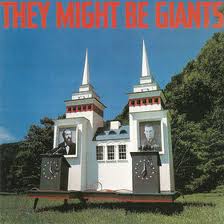 Lincoln (1988): Part two of the classic era, with a higher quotient of honest-to-goodness pop songs, but just as brilliant.
Lincoln (1988): Part two of the classic era, with a higher quotient of honest-to-goodness pop songs, but just as brilliant.
”Ana Ng,” their second college radio, leads the album off; a song about a girl who lives precisely on the other side of the world (so as John Linnell explains, since it’s a Vietnamese name, it’s obviously sung by someone living in Peru), it’s a strong contender for the catchiest pop song of TMBG’s entire career to date.
Lincoln then expands into a more organic-sounding record than the debut, but with just as many experiments. Side 1 is a little more conventional, as least for TMBG, with energetic romps like ”Purple Toupee,” ”Mr. Me” and ”Where Your Eyes Don’t Go” (which features some excellent guitar riffing at the end and perhaps my favorite TMBG lyric of all time: ”Every jumbled pile of person has a thinking part that wonders what the part that isn’t thinking isn’t thinking of”). But side 2 is a wild ride of randomness, featuring the anti-Christmas Carol ”Santa’s Beard,” the power-pop gem ”They’ll Need A Crane”, the melancholy ”Snowball in Hell” (featuring my second-favorite TMBG lyric of all time: ”oh, I see, back on that old time is money kick again? Not back on it – Still on it”) and the short-but-sweet ode to individuality ”Shoehorn With Teeth.”
The album concludes with ”Kiss Me, Son Of God,” a sing-along ballad about an exploiter of the working class. Gotta love it. And like the first LP, there are some great B-sides from this period that are now bonus tracks on the ”Then” reissue, such as ”Nightgown Of the Sullen Moon” and ”Hey Mr. DJ, I Thought You Said We Had A Deal.”
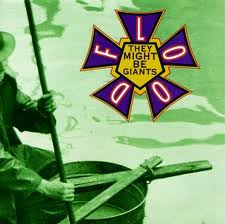 Flood (1990): More folks will probably say that this is the best TMBG album for any initiate to start out with than any other. No argument here, even though I still slightly prefer Lincoln. This was the record that broke the Giants big to alternative rock audiences everywhere, and it’s easy to see why.
Flood (1990): More folks will probably say that this is the best TMBG album for any initiate to start out with than any other. No argument here, even though I still slightly prefer Lincoln. This was the record that broke the Giants big to alternative rock audiences everywhere, and it’s easy to see why.
The first half of the album in particular is chock full of songs that are so easy to sing along to, it’s kind of scary. I can still remember breaking into spontaneous choruses of ”Lucky Ball and Chain,” ”Dead,” ”We Want A Rock,” ”Particle Man,” and of course ”Istanbul” in the high school hallway in free periods. ”Istanbul,” arguably their best-known tune, is in fact a cover version of a song originally recorded by the Canadian vocal group The Four Lads that reached #10 on the Billboard charts in 1953, and is the first in a long line of TMBG songs that are either outright covers or make clever references to popular songs of the past.
The alternative hit ”Birdhouse In Your Soul” is here too, of course, as is ”Your Racist Friend,” one of the great examples of metal, hip-hop and calypso influences all in the same song. OK, the only example. The album loses a step or two in its latter half, but only a little bit. There’s still the quirky ”Someone Keeps Moving My Chair,” ”Whistling in the Dark,” an irresistible singalong that recalls ”Shoehorn With Teeth” but with a marching drum, and the slightly-disturbing instrumental ”Minimum Wage.”
Side 1, however, from the opening ”Theme From Flood,” through ”Birdhouse,” ”Lucky Ball and Chain,” ”Istanbul” (the first inkling we get of their future interests in songs for kids), ”Dead”, ”Your Racist Friend,” the Costello-esque ”Twisting,” and the folksy ”We Want a Rock” is the best continuous 20 minutes of their career and – I’ll go so far as to say – one of the best sides in the whole pop/rock genre ever. And it’s funny how with ”Particle Man,” ”Istanbul,” and ”Whistling in the Dark” you get the sense that they were closet kids music fans, more than 10 years before their first actual kids CD.
Apollo 18 (1992): So let’s just get this over with now. No They Might Be Giants album they’ve recorded since 1990 has topped the self-titled debut, Lincoln or Flood and nothing they record in the future ever will. One could easily stop right here at Flood and imagine that TMBG was this great, lost underground band of the late 80s that made three albums and tasted a hint of success before the Johns tragically went their separate ways to do inferior solo projects, and by now they’d be enjoying Nirvana-esque levels of critical acclaim.
In spite of that, they continue to be worth following to this day. Many of their albums in the last 19 years would be the highlights of other artists’ careers. But it’s the lyrical brilliance in particular that sets the first three albums apart. TMBG’s early lyrics, for nearly every song, straddle the line in between meaningfulness and wacky obliqueness like no other rock artist has ever done (Steely Dan is the only comparable act I can think of). Since 1992, though they continue to write excellent lyrics, that fine line has been harder to reach; a much larger percent of their songs than before are either pretty darn obvious (e.g. ”Mammal,” ”XTC vs. Adam Ant,” ”Man, It’s So Loud”) or are complete head-scratchers (e.g. ”Hall Of Heads,” ”Exquisite Dead Guy,” ”Wearing a Raincoat”).
The combination of a higher quotient of songs that actually seem to about something fairly straightforward and the presence of a full band makes them sound just a wee bit more like everyone else. But only a wee bit, which means they still don’t really sound like anyone else, most of the time.
There, now that we’ve gotten that out of the way, let’s see what the last 19 years of TMBG have to offer us.
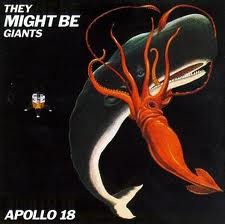 So, Apollo 18. Now, due to the issues above, as a 20-year-old college radio snob, I was initially unimpressed by this album as a whole when it was first released. I thought that all the lyrical subtlety had been blown out the window, and with one glorious exception (more on that soon), the anything-goes attitude had been muted.
So, Apollo 18. Now, due to the issues above, as a 20-year-old college radio snob, I was initially unimpressed by this album as a whole when it was first released. I thought that all the lyrical subtlety had been blown out the window, and with one glorious exception (more on that soon), the anything-goes attitude had been muted.
Having a neighbor down the dormitory hall who couldn’t stop blasting this CD didn’t help. Neither did ”The Guitar,” which I still just can’t get excited about. But this album has largely redeemed itself in my head since those days, and no one can deny that it’s just plain fun. I still don’t get ”Hall Of Heads,” but its surf-rock intro is totally cool. I don’t really get ”Dinner Bell” either but it’s TMBG wordiness at its best. The new-wavey ”See the Constellation” is a long-time favorite of mine, and the superhero spoof ”Spider” is just the right length. The jazzy ”She’s Actual Size” captures the feel of early TMBG perhaps better than anything else. And ”The Statue Got Me High” and ”I Palindrome I” were both excellent singles in the classic TMBG power-pop vein.
If for no other reason, though, this album must be owned for ”Fingerprints,” the unique pastiche of about 20 different ”songs” lasting between 5 and 30 seconds each. Each little mini-song is making fun of a certain style, or in some cases a certain artist. All in all, this album is mostly great as long as you don’t hold it to the standards of their earlier work, and it signifies the end of TMBG’s pre-band era.
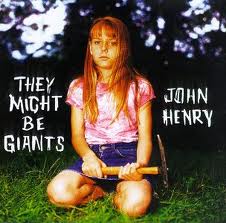 John Henry (1994): Ever the contrarian, I liked this album immediately when it was new, whereas most people I knew who had loved TMBG up to that point hated it.
John Henry (1994): Ever the contrarian, I liked this album immediately when it was new, whereas most people I knew who had loved TMBG up to that point hated it.
Though the big lyrical paradigm shift already happened with Apollo 18 this is where the big musical paradigm shift occurred, as TMBG went to the studio with a full band, largely abandoning the drum machines and accordions of their early years. I still remember reading the review of this album in my college newspaper and being disgusted that the reviewer was not being open-minded; she criticized John Henry for having too many depressing songs, for changing the sound away from the TMBG she knew and loved, for not putting enough smiles on her face. As Joni Mitchell once quipped in the mid-70s, ”No one ever asked Van Gogh to paint another Starry Night.’”
Furthermore, I wondered where this reviewer was during ”Alienation’s For the Rich,” ”Pencil Rain” and ”Dig My Grave” — it’s not like they had never been depressing before. To be fair, I do think they got a little carried away with the horn section on this album, to the detriment of overall variety of instruments, and a few of the tracks would be more effective at two minutes than at four minutes. But the more one listens to this, the more one realizes it really is the same TMBG we know and love after all. The experiments, such as the barbershop-esque ”O Do Not Foresake Me,” the lounge-jazzy ”Extra Savior Faire,” the historical lesson ”Meet James Ensor,” and the neo-psychedelic ”A Self Called Nowhere” are as wacky and unique as ever.
What’s new, though, is that the musical chops are let loose — the band lays down super-funky grooves on the underrated single ”Snail Shell,” and ”No One Knows My Plan,” effortlessly changes speeds on ”Sleeping in the Flowers,” tears through ”Stomp Box” like there’s no tomorrow, and simply abandons any semblance of structure on ”Spy,” which is even better live. Not every track is a winner, but there’s plenty to love here, and it fits in much better with the overall TMBG picture now than it did at the time.
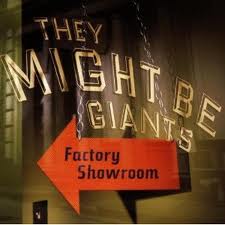 Factory Showroom (1996): This has never been one of my go-to TMBG albums, but it has grown on me through the years. Very different from John Henry, it has a much more stripped-down feel, and even more than its predecessor, it finds the Johns trying to be more of a conventional band.
Factory Showroom (1996): This has never been one of my go-to TMBG albums, but it has grown on me through the years. Very different from John Henry, it has a much more stripped-down feel, and even more than its predecessor, it finds the Johns trying to be more of a conventional band.
It often feels like they were under pressure to come up with something quickly and churned this out without it really being a finished product. Only 13 songs (by far the fewest of any TMBG album to that point), with one cover (”New York City”), and one inferior re-recording of ”James K. Polk” from the ”Istanbul” CD single in 1990, so essentially there were only about half as many new original songs as on any previous album.
There are certainly some good tunes here; ”Spiraling Shape” seems to be a just-say-no song done with just enough ambiguity that it could just be about… well… a Spiraling Shape. The zany and fast-paced ”Till My Head Falls Off” and the soulful ”Pet Name” are my other two favorites here. And I’d be remiss if I didn’t mention ”I Can Hear You,” perhaps their most experimental song of all time in that it was recorded without electricity on an 1890s wax cylinder. Some of this album, though, just leaves me either wanting more (”XTC vs Adam Ant,” ”S-E-X-X-Y”) or wondering what the joke is (”How Can I Sing Like A Girl,” ”Exquisite Dead Guy.”) It’s not bad, don’t get me wrong, and explores some deeper and more unusual topics on average than many of their albums.
We now get ourselves into a very strange and muddled period in TMBG history. You’ll see what I mean.
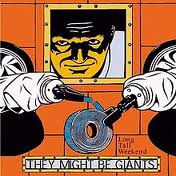 Long Tall Weekend (1998): The first ever internet-only release by a major rock band, but since most of the world did not yet have high speed internet or portable mp3 players in 1998, it was a little premature to do this. Even music geeks like me were not aware of this album’s existence until at least 2000. You can still download it from TMBG’s website today, but like Factory Showroom, I wouldn’t put this high on the list of essential’ TMBG releases.
Long Tall Weekend (1998): The first ever internet-only release by a major rock band, but since most of the world did not yet have high speed internet or portable mp3 players in 1998, it was a little premature to do this. Even music geeks like me were not aware of this album’s existence until at least 2000. You can still download it from TMBG’s website today, but like Factory Showroom, I wouldn’t put this high on the list of essential’ TMBG releases.
As if to correct for their prematureness, many of the songs here later showed up on Mink Car in 2001, the rarities collection They Got Lost in 2002, or the kids album No also in 2002 (though in most cases, I like the Long Tall Weekend versions better). There’s kind of a homogenous sheen among most of these tracks that I can’t put my finger on, which makes it less of a drop-everything listen than most of TMBG’s albums. But it’s not without its redeeming points.
”Reprehensible” is a cool jazzy number with signature philosophizing, ”She Thinks She’s Edith Head” is a fun and danceable punk rock concoction, and ”Older”… well, I won’t ruin the joke. The two best-known TMBG songs from the late 90s, however, did not make it on here: ”Doctor Worm” was only released as a new studio track on the live Severe Tire Damage album, and ”Boss of Me” was just a single, as the theme to the TV show ”Malcolm in the Middle.” Both are now available on TMBG’s Dial a Song compliation.
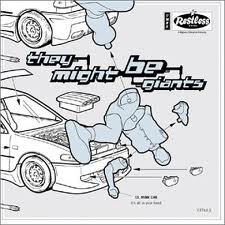 Mink Car (2001): Oh, what could’ve been… the first proper CD release in five years and with their freshest-sounding and most varied material since the early 90s, this had all the makings of the great comeback album, but had the misfortune to have been released on… you guessed it, September 11th, 2001.
Mink Car (2001): Oh, what could’ve been… the first proper CD release in five years and with their freshest-sounding and most varied material since the early 90s, this had all the makings of the great comeback album, but had the misfortune to have been released on… you guessed it, September 11th, 2001.
The scene in the must-see TMBG documentary Gigantic: A Tale Of Two Johns has John and John performing the song ”New York City” in Tower Records in Manhattan for the midnight CD release party, and it bring chills to anyone’s spine, looking at the innocent, partying crowd, poised to make Mink Car a success, having no idea what was to transpire a mere nine hours later. Because of that, Mink Car remains an album that mostly only fans know about, but for my money is their best recording since 1990.
Like their early albums, it plays like a multi-genre jukebox where anything and everything is fair game, but it doesn’t just rehash what they did before; on the contrary, there are bold new directions at every turn; the techno spoof ”Man, It’s So Loud In Here”, the Irish pub anthem ”Drink,” the 60s space-loungey title track, the glam-rock send-up ”I’ve Got a Fang,” the awesome ode to Boston ”Wicked Little Critta” (OK, so I’m a little biased about that one) the list goes on and on. Two of the better tunes from Long Tall Weekend show up here too (”Older” and ”She Thinks She’s Edith Head”), as well as ”Working Undercover For the Man,” released originally on an EP in 1999. In all three of those cases, I like the original versions better, but simple playlisting can remedy that situation. If you want to hear just one post-1990 TMBG album, this is the one to get.
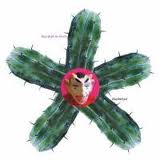 They Got Lost (2002): This completes the late 90s / early 00s picture with various odds and ends, and is really mostly a ”for completists only” release. It’s a weird song selection, in that it pulls some tracks that aren’t actually rare per se, having been on various previous releases, (a couple that were previously ”hidden” but many that weren’t), but is the only place you can find many of the other tracks.
They Got Lost (2002): This completes the late 90s / early 00s picture with various odds and ends, and is really mostly a ”for completists only” release. It’s a weird song selection, in that it pulls some tracks that aren’t actually rare per se, having been on various previous releases, (a couple that were previously ”hidden” but many that weren’t), but is the only place you can find many of the other tracks.
The best songs here that you can’t find anywhere else are ”Rest Awhile,” which has a classic early TMBG feel, and the hilarious ”Disappointing Show,” probably written in response to a negative review of a concert. What was disappointing though, is that the title track is the same version that’s on Long Tall Weekend. It’s a very cute self-referential story song about the two members of TMBG losing their way on a road trip, but the best version is the faster-paced one on the live Severe Tire Damage CD, and it would’ve been nice to hear a studio version at the faster tempo.
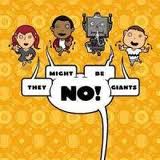 No (2002): The first, and still the best TMBG kids album, and different from the other ones to date in that it doesn’t have an overarching educational theme, it’s just a kids album in general. But the lyrics are in most cases enjoyable on two levels, and it doesn’t have that glossy kids’ music production; it feels for the most part like music that could exist on any one of their ”adult” albums.
No (2002): The first, and still the best TMBG kids album, and different from the other ones to date in that it doesn’t have an overarching educational theme, it’s just a kids album in general. But the lyrics are in most cases enjoyable on two levels, and it doesn’t have that glossy kids’ music production; it feels for the most part like music that could exist on any one of their ”adult” albums.
And that’s what makes it so good; it doesn’t condescend like so much media made for kids these days. The punk-rock-ish title song is arranged to embody what the repeated ”no”s that kids hear sound like to them. ”Where Do They Make Balloons” has a melody you just can’t shake and sounds like a long lost Fifth Dimension single. ”Four Of Two” tells the story of a man daydreaming just before a date, and could easily fit on any of TMBGs other albums. (As an aside, my favorite NPR show ”Wait Wait Don’t Tell Me” has glommed on to the musical refrain in this song and uses it repeatedly as a segue in between sections of the show). ”Robot Parade,” originally on Long Tall Weekend, gets slowed down and more kid-friendly but is just as cool in this form. Also rescued from Weekend is ”The Edison Museum,” which works well as a ghost story (with the priceless punchline that it’s in New Jersey).
The framework of a kids record allows the Johns to get even zanier than usual, too, with a truly bizarre counting song (”Violin”) a nearly-as-bizarre personification of a common household item (”I Am Not Your Broom”), and the story of a man with extra-sensitive taste buds, done in 70s soundtrack style (”John Lee Supertaster“). You don’t have to be a kid to love this album; it’s one of their best in general. Certainly their funniest. And you can bet it’ll be on heavier rotation when my daughter is in preschool than anything with Elmo involved.
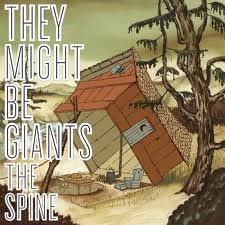 The Spine (2004): As the follow-up ”grownup album” to Mink Car, what threw me for a loop at first was how safe this album felt, as if TMBG wanted to compete with all the other white-boy alterna-pop bands out there. Tracks like ”Thunderbird,” ”Damn Good Times,” ”Broke In Two,” and ”Prevenge” all seemed, so, well… normal. Only the hilarious vocorder send-up ”Bastard Wants To Hit Me,” and the retro-jazzy ”Au Contraire” and ”Stalk Of Wheat” seemed to retain the traditional spirit of what TMBG was all about (and the humor on even those songs seemed more forced than typical).
The Spine (2004): As the follow-up ”grownup album” to Mink Car, what threw me for a loop at first was how safe this album felt, as if TMBG wanted to compete with all the other white-boy alterna-pop bands out there. Tracks like ”Thunderbird,” ”Damn Good Times,” ”Broke In Two,” and ”Prevenge” all seemed, so, well… normal. Only the hilarious vocorder send-up ”Bastard Wants To Hit Me,” and the retro-jazzy ”Au Contraire” and ”Stalk Of Wheat” seemed to retain the traditional spirit of what TMBG was all about (and the humor on even those songs seemed more forced than typical).
But, for better or for worse, the Johns are evolving, and if they want to out-Weezer Weezer, we should give them a shot at it. Little by little, this album has grown on me. ”Broke in Two” with its early 80s synth-pop leanings, has become one of my favorite recent tracks in spite of its normailty, and ”Experimental Film” is one of the better of their catchy power-pop album-openers. ”Memo To Human Resources” is another brilliant little tune that didn’t quite click initially.
I still don’t think their dance-oriented experiments like ”It’s Kickin’ In” really work, but that might just be my personal distaste for that kind of music. Don’t run out and grab this before Mink Car, but if you like TMBG in general, you’ll put this one on from time to time. Oddly, the album is rather short, the concurrent Spine Surfs Alone EP had seven pretty good ”mini-songs” that fall into the wackier category, and mixing the two together would’ve made an album that retained the feel of the classic 20-song TMBG release and still clocking in under an hour. It’s almost as if they’re editing out their eccentric side for hardcore fans (the only ones who will buy the EPs).
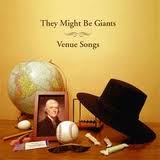 Venue Songs (2005): Released originally as a story DVD and then later a download on the group’s website with very little fanfare (I didn’t even know about it until several years later), this was the result of a challenge posed to John and John to write a song inspired by every venue on their tour. File this in the ”for hardcore TMBG fans only” category, but it’s quite amusing.
Venue Songs (2005): Released originally as a story DVD and then later a download on the group’s website with very little fanfare (I didn’t even know about it until several years later), this was the result of a challenge posed to John and John to write a song inspired by every venue on their tour. File this in the ”for hardcore TMBG fans only” category, but it’s quite amusing.
Most of the songs’ are little ditties barely over a minute, but not bad for having to write them on the day of each show. This experiment does showcase the versatility and humor of TMBG as well as one could hope. My favorites are the odes to Glasgow’s ”The Garage” (where they spell the letters out a la the Bay City Rollers’ ”Saturday Night”), Charleston’s ”Music Farm” (where they fantasize about what a traditional farm would be like if its main crop were… you know, music), Los Angeles’ ”House of Blues” (where the masquerade as arrogant British rockers who think every American band is out to steal their ideas) and especially Dallas’s ”The Trees” which evokes (and slightly mocks) Yes so brilliantly that any Yes fan will want to listen it about 10 times in a row so it can be stretched from 45 seconds into 7 minutes. Most of this is a live album, but since these songs don’t appear on any of their studio releases, I felt it warranted inclusion here.
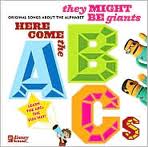 Here Come the ABCs (2005), Here Come the 123s (2008): The first two in a series of three (so far) educational CDs (with optional DVDs), and all three retain the eclecticism that characterizes TMBG’s music.
Here Come the ABCs (2005), Here Come the 123s (2008): The first two in a series of three (so far) educational CDs (with optional DVDs), and all three retain the eclecticism that characterizes TMBG’s music.
Sure, they’re singing about letters and numbers, but they keep things interesting for grownups with tracks like ”Alphabet Lost and Found” (which could’ve been a new wave hit from 1982 with different lyrics), the folkish ”C is for Conifers,” ”Who Put the Alphabet in Alphabetical Order?” (priceless!), and the disco-like ”High Five.” The 123s CD has a higher quotient (no pun intended) or signature TMBG-esque songs, like ”Triops Has Three Eyes,” ”Nonagon,” ”Hot Dog” and ”I Can Add.”
A few of the songs make more sense when seen 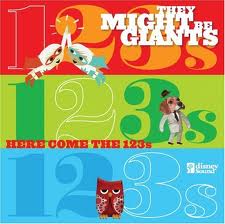 on the DVD. I don’t yet know from first hand experience whether kids actually learn anything from these albums, but at the very least, they’re way more fun to sing along to than, say, Barney, and given how much kids like to repeat listening to their favorite music over and over, I highly recommend you get this on the stereo early before they find out about some less attractive alternatives.
on the DVD. I don’t yet know from first hand experience whether kids actually learn anything from these albums, but at the very least, they’re way more fun to sing along to than, say, Barney, and given how much kids like to repeat listening to their favorite music over and over, I highly recommend you get this on the stereo early before they find out about some less attractive alternatives.
The Else (2007): This is perhaps their most rockin’ album, but like The Spine, it’s a short album that feels kind of safe musically. Also like The Spine, a concurrent release (Cast Your Pod to the Wind, which I’ll review below) takes a lot more risks and some or all of it could’ve been mixed in to capture the more varied feel that distinguishes TMBG from their peers (don’t get me wrong, I don’t necessarily want TMBG to keep replicating the sound of their early work, just the feel).
Some tracks, like ”Upside Down Frown” and ”The Cap’m,” feel like they’re 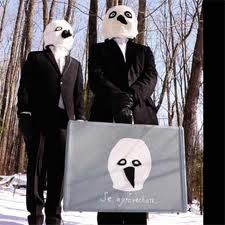 trying a little too hard to be funny, and some others like ”Feign Amnesia” and ”I’m Impressed” have that same ”normal” feeling you get from much of ”The Spine.” So it’s easy to complain a little. But safe for TMBG is still pretty strange for anyone else, and there’s plenty of fun to be had here.
trying a little too hard to be funny, and some others like ”Feign Amnesia” and ”I’m Impressed” have that same ”normal” feeling you get from much of ”The Spine.” So it’s easy to complain a little. But safe for TMBG is still pretty strange for anyone else, and there’s plenty of fun to be had here.
The jealousy-ridden garage-rocker ”Take Out The Trash” could’ve been a hit had it been recorded by someone younger and hipper (Smashmouth?). ”The Mesopotamians,” a sly update of ”We’re the Replacements,” is an irresistible theme song for a non-existent rock band no one’s ever heard of. ”Bee Of The Bird Of The Moth” is the latest entry in the They Might Be Giants sci-fi story sub-genre. And ”With the Dark” is the one place where they pull out the stops and try a new style of music, this time a mini-rock opera. It’s certainly a good album, but it feels like something isn’t quite right. So now let’s get to…
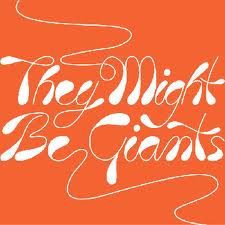 Cast Your Pod to the Wind (2007): Released as a ”bonus disc” with ”The Else” for a limited time, but fortunately still available as an mp3 download on TMBG’s website, this has a lot of what’s missing from The Else. Most of the tracks are less than two minutes.
Cast Your Pod to the Wind (2007): Released as a ”bonus disc” with ”The Else” for a limited time, but fortunately still available as an mp3 download on TMBG’s website, this has a lot of what’s missing from The Else. Most of the tracks are less than two minutes.
It was meant to be just a compilation of songs that had been on recent podcasts, which have taken the place of the ”Dial-a-Song” service they ran for many years, but there’s a larger portion of true keepers than on They Got Lost. Really, there are at least 7 or 8 tracks that are just as good as most of The Else, and as I say above, could’ve been mixed into that album and given it the eclecticism in which it is somewhat lacking.
”Sketchy Galore,” ”Kendra McCormick,” ”Scott Bower” and ”Yeah, The Deranged Millionaire” recall the classic story songs of unusual characters (e.g. ”Chess Piece Face,” ”Mr. Me”) without being simply retreads. Moments of pure insanity like ”Brain Problem Situation,” ”Mexican Drill,” ”Homunculus” (featuring some White Stripes-ian guitar licks) and ”Vestibule” would add some much-needed spice. And ”Why Did You Grow A Beard,” ”I’m Your Boyfriend Now” and ”Employee Of The Month” are simply too hilarious to relegate to collectors’-bonus-disc land.
The Alternate Else (hypothetically 2007): Given the above, I thought I’d offer my take on what The Else COULD have been. 22 tracks, but still only 53 minutes (11 tracks from the original The Else and 11 from Cast Your Pod — yes, I left out ”Upside Down Frown” and ”Withered Hope,” I’m not really a big fan of either).
I’m Impressed
Take Out The Trash
Why Did You Grow A Beard
Homunculus
I’m Your Boyfriend Now
Climbing The Walls
Sketchy Galore
With The Dark
Brain Problem Situation
Scott Bower
Careful What You Pack
The Shadow Government (this would lead off ”side two” on any LP pressings)
Yeah, The Deranged Millionaire
The Cap’m
Bee Of The Bird Of The Moth
Employee Of The Month
Contrecoup
Feign Amnesia
Kendra McCormick
The Mexican Drill
Vestibule
The Mesopotamians
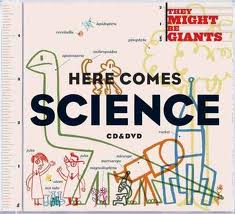 Here Comes Science (2009): Back to a kids album. This differs from the ABCs and 123s CDs in that it’s aimed at a slightly older audience (roughly ages 8-12), and could even be a nice refresher for us adults.
Here Comes Science (2009): Back to a kids album. This differs from the ABCs and 123s CDs in that it’s aimed at a slightly older audience (roughly ages 8-12), and could even be a nice refresher for us adults.
It’s a natural extension of some earlier science songs – ”Why Does The Sun Shine” was originally recorded in 1959 on a kids ”Space Songs” LP, covered by TMBG on an EP in 1993, has been a concert staple for years, and is included here both in sped-up form (similar to how they play it live) and in an alternate version that updates the facts from the sun being a mass of gas to a miasma of plasma.
”My Brother the Ape,” a clever story about trying to deny one’s chimp heritage, wouldn’t be out of place on Apollo 18. ”Science Is Real” seems pretty innocuous at first, but could double as a little jab towards the people who are still claiming global warming is a hoax. Along similar lines, ”Electric Car” brilliantly combines 80s synth verses with a 70s soul singalong chorus and could be the pop song that propels the Chevy Volt to the masses in an alternate reality.
This is a very fun listen, even more than the prior Here Comes CDs, and leaves me wondering what’s next. Here Comes History? Here Comes Economics? Here Comes Politics? (Hoo boy, they’d have fun with that one…)
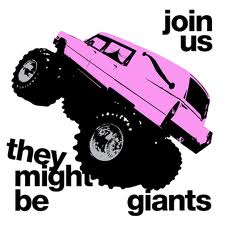 Join Us (2011): And finally, we’re here, today.
Join Us (2011): And finally, we’re here, today.
Now, I’ve only listened to it once, so I don’t want to fall into the trap of embracing the new too easily, but early impressions are very good. Much to the delight of longtime fans, this new release hearkens back to the early days in many ways, or at least the Apollo 18 / John Henry / Factory Showroom days.
There’s more of a positive, less cynical feel in songs like ”You Probably Get That A Lot” (kind of a three minute apologetic pick up line) and ”Let Your Hair Hang Down,” a shameless attempt to recreate the 60s southern California style. And the more off-beat tracks like ”Cloisonne” do a better job of being just meaningful enough to evoke some thought, in contrast to the more forced-sounding humor of some recent material.
The album really delves into some weirdness near the end, with the Johns singing simultaneous stories each in one channel on ”Spoiler Alert,” some time travel antics on ”2082,” and some cool finger-snapping call and response numbers like ”Protagonist” and ”Three Might Be Duende.” But yet they’re not above doing a pure pop song like ”I Never Knew Love” or a direct-warning-about-woman-who-can-only-be-trouble song like ”Judy Is Your Vietnam.” Join Us seems to be a microcosm of the entire They Might Be Giants catalog, and contains some of their strongest songwriting in years. Check it out.
Final reader poll: I’ve always wanted to find opinions about who TMBG is specifically trying to imitate in various parts of ”Fingerprints,” and this seems like the perfect forum in which to do so. So anyone commenting, please feel free to contribute any ideas you may have! I’ll start with one: I always thought that ”I walk along darkened corridors” HAD to be an ode to Morrissey / The Smiths.





Comments